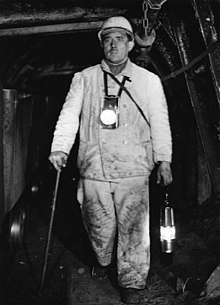Steiger (mining)
A Steiger (literally "climber") is the title of a mining foreman or mine manager, used in German-speaking Europe. He bears responsibility for part of the mine and the people subordinated to him. The name is derived from the former role of a Steiger, who continually had to climb into and out of the pit.[1] The Steiger is celebrated in a very popular German mining song the so-called Steigerlied (Glückauf, Glückauf; der Steiger kommt …).

Historical role
In medieval and early modern times, the state mining regulations obliged mining companies to employ pit officials for the supervision of their mines. Until the mid-19th century, these officials were civil servants. The term Steiger for these pit officials became established very early on in the mining regulations. The hiring and firing of pit officials was the responsibility of the mining authority or Bergamt; at best the mine owners had a say and could impress their wishes on the Bergmeister in this regard. With the reform of mining law in the years from 1851 to 1865, there was a change in the official status of the Steiger. The Steiger was no longer a state official, but a private officer.[2] Despite this change, Steigers continued to be employed by the mining authority.[3]
References
- Heinrich Veith: Deutsches Bergwörterbuch mit Belegen. Verlag von Wilhelm Gottlieb Korn, Breslau 1871
- Helmuth Trischler: Steiger im deutschen Bergbau - Zur Sozialgeschichte der technischen Angestellten 1815-1945. Beck, Munich, 1986, ISBN 3-406-32995-0
- Otto Hue. Die Bergarbeiter., Vol. 2, published by JHW Dietz, Stuttgart, 1913